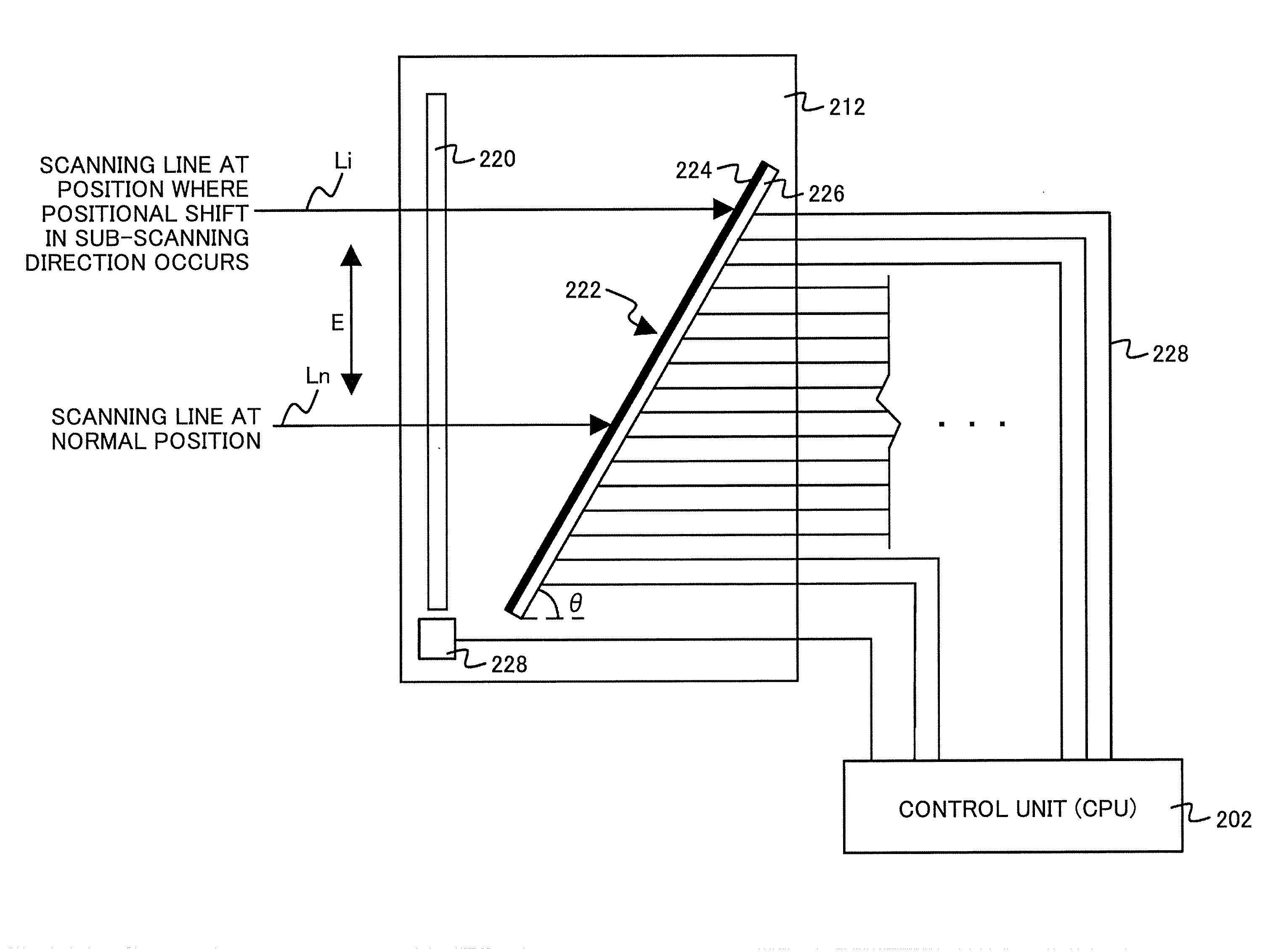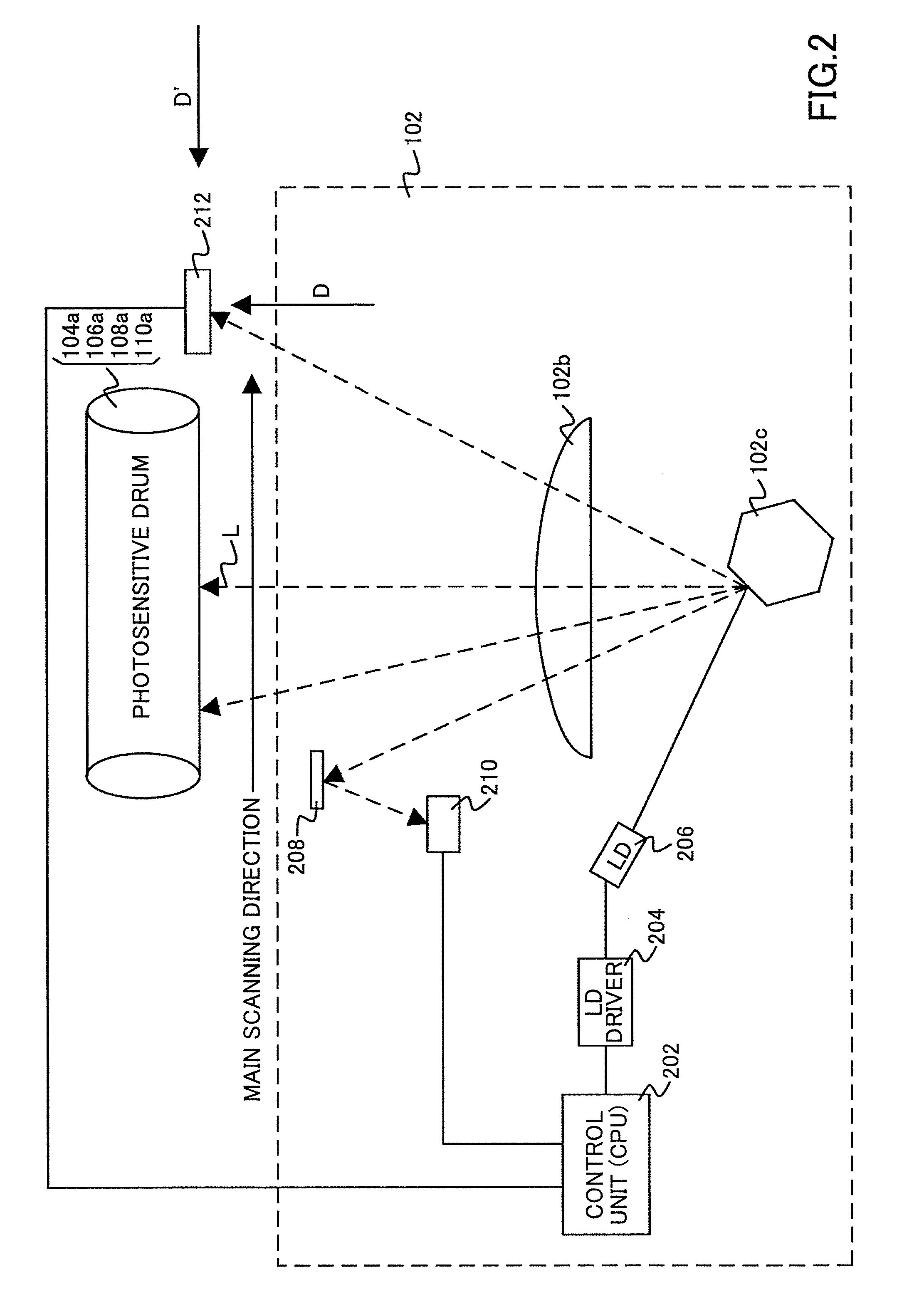Image forming apparatus and image forming method
- Summary
- Abstract
- Description
- Claims
- Application Information
AI Technical Summary
Benefits of technology
Problems solved by technology
Method used
Image
Examples
first embodiment
[0056]In the case of the first embodiment shown in FIG. 4, an amount for correcting the positional shift in the sub-scanning direction can be calculated by the following formula (1) using the values of T1 and T2 based on the irradiation signal 400.
[Formula 1]
[0057]
y=CONST×(T2−T1)×tan θ (1)
[0058]wherein CONST represents the moving speed (mm / s) of an optical beam in the main scanning direction and is determined by the rotational speed of the polygon mirror 102c. Furthermore, y represents a scanning shift amount (mm) in the direction orthogonal to an optical beam in the sub-scanning direction, T1 and T2 represents a time difference until the detection signal is acquired, and θ represents an angle (rad or deg) of the irradiation position sensor relative to an optical beam.
[0059]According to another embodiment of the detection device 212, it is also possible to directly detect a difference between the scanning positions of the optical beams Ln and Li to measure a shift amount in the sub...
second embodiment
[0061]FIG. 6 shows a detection circuit including the CPU 202 and a control method. The CPU 202 is configured to be an ASIC including a system clock input port 604 and a reset port 606. Furthermore, the CPU 202 is composed of an output port 602 including plural ports and an input port 608 including plural ports that receives the detection signals from respective channels of the light receiving element. A gate signal 610 is generated as a pulse having a predetermined gate width, and in the embodiment shown in FIG. 6, a pulse train of delay time in which plural gate signals are sequentially set is generated over a gate period TG. The gate signal is used as the gate signal of the optical sensor 226. Where the emission of light attributable to an optical beam is detected when a gate potential is asserted (HIGH in the embodiment shown in FIG. 6), the detection signal is generated so that the gate potential is asserted LOW. Note that the time interval of the gate signal and the gate period...
third embodiment
[0063]FIG. 7 shows the detection circuit including the CPU 202 and the control method. In the embodiment shown in FIG. 7, the CPU 202 generates the gate signal 610 from the output port 602 over the gate period TG. On the other hand, the optical sensor 226 is made of a two-dimensional photodiode array, a CCD, or a CMOS sensor comprising a two-dimensional channel. In the optical sensor 226, a row address and a column address are specified for each channel, and the optical sensor 226 sends the output of the addresses to the CPU 202 via an appropriate interface. The CPU 202 acquires the values of the row address and the column address of the channel where the detection signal is asserted. Then, in order to control the position in the sub-scanning direction, the CPU 202 calculates the shift amount of the optical beam Li in the sub-scanning direction by referring to the shift amount data of the look-up table or the like in which are stored the differences between the values of the acquire...
PUM
 Login to View More
Login to View More Abstract
Description
Claims
Application Information
 Login to View More
Login to View More - R&D
- Intellectual Property
- Life Sciences
- Materials
- Tech Scout
- Unparalleled Data Quality
- Higher Quality Content
- 60% Fewer Hallucinations
Browse by: Latest US Patents, China's latest patents, Technical Efficacy Thesaurus, Application Domain, Technology Topic, Popular Technical Reports.
© 2025 PatSnap. All rights reserved.Legal|Privacy policy|Modern Slavery Act Transparency Statement|Sitemap|About US| Contact US: help@patsnap.com



